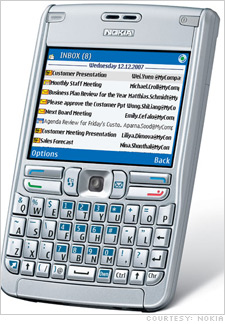|
Is Nokia's E62 smart enough? The cell-phone giant plans to break Palm and RIM's lock on the U.S. smartphone market with a powerful, affordable phone.
(Business 2.0 Magazine) -- It's not often that Nokia finds itself the underdog. But in the business of smartphones - powerful wireless devices that can handle e-mail and office documents in a compact package - that's exactly where the world's largest cell-phone maker stands. With nearly 50 percent market share, Nokia (Charts) reigns over smart device sales worldwide. In the United States, though, it lags behind more entrenched players like Palm (Charts),Motorola (Charts) and RIM (Charts), maker of the BlackBerry. Here, Palm's Treo and Research In Motion's BlackBerry dominate smartphone sales, together holding more than 70 percent of the market.
With its new E62 smartphone, unveiled at this month's CTIA IT & Entertainment show in Los Angeles, Nokia is hoping to change the game with an unbeatable proposition - price. A high price has long been the weakness of smartphones. Early adopters and gadget hounds have been willing to shell out hundreds of dollars for the latest, most capable devices. But for the mass market, which is used to heavily subsidized phones that often come free with service, paying more than $100 for a cell phone comes as a shock. If the much-anticipated E62 lives up to its hype, the phone could boost Nokia's U.S. market share - and jumpstart the entire smartphone market. Nice price At barely half an inch thick, the E62 - an Americanized version of Nokia's popular E61 -- features a full QWERTY keypad, 80 megabytes of built-in memory, and support for a variety of e-mail platforms. But you'll find those features in Treos and BlackBerrys, too. So just what does the E62 have that other smartphones don't? Arguably, its most striking feature is an affordable price tag: Starting at the end of September, it will be available for as little as $150 from Cingular, its exclusive U.S. carrier. RIM's new BlackBerry Pearl sells for $199, while Palm's cheapest new phones go for $299. (All of these prices require signing up for some form of service contract.) Nokia spokesperson Laurie Armstrong says that it's the E62's features, not its price tag, that are most compelling. But according to analysts, lower prices are what's needed to drive rapid uptake in U.S. smartphone sales, which -- despite accounting for about 20 percent of new cell phone purchases -- still make up just 3 percent of total mobile phone subscriptions nationwide. Of course, Nokia's not the only one pushing sleek phones at lower price points. Selling for as little as $199, Motorola's recently launched Q smartphone also attracted customers with a relatively affordable price tag (not to mention Razr-like looks). And Nokia's got plenty of other U.S. competition, affordable or not, to contend with. RIM's new BlackBerry Pearl is already earning major cool points for its sleek design. Palm, maker of the popular Treo smartphone, is set to release an additional two smart devices in the United States by end of this year. "Price only opens the door," says Jim Christensen, director of product communications at Palm. "But if you take a device home and it doesn't meet your expectations, it's going right back to the store." Smart enough? Indeed, despite Nokia's high hopes (and plenty of rave reviews), some analysts are skeptical the E62 has what it takes to become Nokia's "it" device for U.S consumers, and significantly drive smartphone sales. "People are always trying to identify the next Razr, or the next paradigm-shifting device," says Chris Ambrosio, director of the wireless device strategy service at Strategy Analytics, a Boston-based research and consulting firm. "The E62 isn't it, though it is a pretty compelling device and definitely a step in the right direction for Nokia." According to Ambrosio, we're still a few years away from smartphone proliferation, and that's not just due to the high cost factor of prevailing U.S. smart devices. Here at home, the mobile market is only about 70 percent saturated, meaning carriers are still focused on growing subscriber numbers by offering heavily subsidized basic phones. In fact, Ambrosio suggests Nokia might have greater success in developing a U.S. smartphone based on its N-series of multimedia phones, which focus on digital-camera and video features, not mobile e-mail. But to meet its goal of changing the game, all Nokia has to do is take some U.S. market share from Palm and RIM - and in a price-sensitive market, where buyers are used to cheap phones, a $50 discount over the competition may well be enough to get it there. |
Sponsors
|

